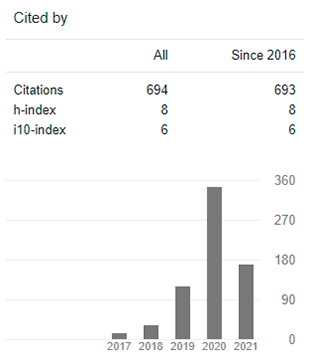Students' Perceptions on the Use of Warm-up Activities in English Language Teaching
Percepciones de los Estudiantes sobre el Uso de Actividades de Calentamiento en la Enseñanza del Inglés
DOI:
https://doi.org/10.29394/Scientific.issn.2542-2987.2024.9.32.1.18-40Keywords:
warm-up activities, language instruction, motivation, english learning, student perceptionAbstract
In English language teaching, integrating warm-up activities is crucial for creating effective and engaging learning classes. This research aimed to determine students' perceptions of the use of warm-ups in English language teaching at a public urban institution. A descriptive-quantitative study was conducted using a survey with an adapted questionnaire. 126 students from the first to third years of high school participated. Data were analyzed using descriptive statistics in Excel. The results showed that warm-up activities are beneficial when applied with the correct principles. They kept students active and mentally prepared, connected prior knowledge with new knowledge, created positive interaction, and increased student motivation. In conclusion, warm-up activities in language teaching promote enthusiasm for developing language skills.
Downloads
References
Akther, A. (2014a,b,c). Role of Warm-up Activity in Language Classroom: a Tertiary Scenario. Dhaka, Bangladesh: BRAC University.
Alaga, N. (2016a,b). Motivation and attitude of students towards learning English language. International Conference on Research in Social Sciences, Humanities and Education. England: Universal Researcher - URUAE.
Đỗ, T. (2013a,b). A study on the use of warm-up activities to motivate grade 10 students in English lessons at ngoc tao high school. Graduation Paper. Hanói, Vietnam: Viet Nam National University.
Dörnyei, Z., & Murphey, T. (2003). Group Dynamics in the Language Classroom. ISBN: 9780511667138. United Kingdom: Cambridge University Press.
Ekiz, S., & Kulmetov, Z. (2016a,b). The Factors Affecting Learners’ Motivation in English Language Education. Journal of Foreign Language Education and Technology, 1(1), 18-38, e-ISSN: 2536-4731. Bursa, Türkiye: Levent Uzun.
Hartina, M. (2020). The Students’ Perception Toward Warming up Activities in Learning English Process. A Thesis. Indonesia: Universitas Muhammadiyah Makassar.
Klippel, F. (1985a,b). Keep Talking: communicative fluency activities for language teaching. Reprinted, ISBN: 0521278716. New York, United States: Cambridge University Press.
Le, T., & Nguyen, T. (2022). Perceptions and Practices of Warm-up Activities by English Teachers in Thai Nguyen. IOSR Journal of Research & Method in Education, 12(3), 05-12, e-ISSN: 2320-7388. India: International Organization of Scientific Research (IOSR).
Lightbown, P., & Spada, N. (2013). How Languages Are Learned. 4th edition, ISBN: 9780194541299. United Kingdom: Oxford University Press.
Loor, J., Cedeño, L., & Cedeño, R. (2020). The advantages of using warm up activities to engagestudents in the english language teaching and learningprocess: an experience from “Go teacher” program. Revista Órbita Pedagógica, 7(1), 75-86, e-ISSN: 2409-0131. Angola: Instituto Superior de Ciências de Educação do Huambo.
McBride, K., (2009). Percepciones Estudiantiles sobre las Técnicas Utilizadas en la Enseñanza del Inglés como Lengua Extranjera. Universum. Revista de Humanidades y Ciencias Sociales, 2(24), 94-112, e-ISSN: 0716-498X. Chile: Universidad de Talca.
Miranda, A., & Calle, J. (2004). Something Old and Something New. Techniques to improve the Lexical Inventory of EST Students: A Proposal. Revista Estudios Ingleses, (17), 6-44, e-ISSN: 0214-4808. Murcia, España: COMPOBELL, S.L.
Paulikova, K. (2018). Creative warm-ups and time fillers for a successful English language class. Slavonic Pedagogical Studies Journal, 7(1), 41-49, e-ISSN: 1339-9055. Retrieved from: https://doi.org/10.18355/PG.2018.7.1.4
Pradnya, Y., & Pavita, M. (2023). The Students’ Perception toward Warming-Up Activities in Increasing the Motivation in Learning Maritime English II. Saintara: Jurnal Ilmiah Imu-Ilmu Maritim, 7(2), 57-62, e-ISSN: 2746-6353. Indonesia: Lembaga Penelitian dan Pengabdian Masyarakat Akademi Maritim Nusantara Cilacap.
Robertson, C., & Acklam, R. (2000a,b,c). Action Plan for Teachers a guide to teaching English. London, United Kingdom: British Broadcasting Corporation.
Safriyani, R., Mahsunah, M., Munawwaroh, A., Usva, A., & Nuriawarti, F. (2020). Students’ Perception About Warming Up in English Learning Process to Improve Students’ Skills: The Case of Eighth-Grade Students at Mts Nurul Islam Pongangan Gresik. e-ISSN: 2352-5398. Proceedings of the International Conference on English Language Teaching (ICONELT 2019). Paris, France: Atlantis Press.
Savaş, H. (2016). Maintaining the efficacy of warm-up activities in EFL classrooms: An exploratory action research. Enad. Eğitimde Nitel Araştırmalar Dergisi, 4(2), 65-85, e-ISSN: 1248-2624. Retrieved from: https://doi.org/10.14689/issn.2148-2624.1.4c2s4m
Sreena, S., & Ilankumaran, M. (2018a,b). Developing Productive Skills Through Receptive Skills - A Cognitive Approach. IJET. International Journal of Engineering & Technology, 7(4.36), 669-673, e-ISSN: 2227-524X. United Arab Emirates: Dubai, Science Publishing Corporation, Inc.
Velandia, R. (2008). The Role of Warming Up Activities in Adolescent Students’ Involvement during the English Class. Profile, 10, 9-26, ISSN: 1657-0790. Colombia: Universidad Nacional de Colombia.
Williams, M. (1998). Ten principles for teaching English to young learners. United Kingdom: Cambridge University Press.
Published
How to Cite
Issue
Section
License
Copyright (c) 2024 INDTEC, C.A.

This work is licensed under a Creative Commons Attribution-NonCommercial-ShareAlike 4.0 International License.
The content of the journals of this site, are under a Creative Commons Attribution-Noncommercial-Share Alike 4.0 International License.













